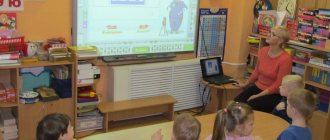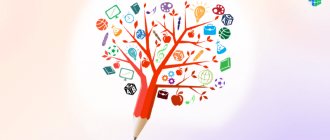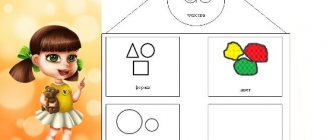ICT in kindergarten
Information and communication technologies in preschool education (ICT) are a complex of educational and methodological materials, programs, technical and instrumental means of computer technology in the educational process, forms and methods of their use to improve the activities of specialists in educational institutions (administration, educators, specialists), and also for the education (development, diagnosis, correction) of children.
The introduction of ICT in kindergarten increases the requirements for the level of professionalism of the teacher, because information culture is part of the general pedagogical culture.
The ICT section of the preschool kindergarten website for different groups contains many interesting publications for educators on various topics:
- ICT in preschool educational institutions
- Summary of GCD with ICT in kindergarten
- Summary of GCD in kindergarten on speech development with ICT, senior preschool age
- Integrated lesson using ICT in the middle group
- Possibilities of using ICT in the educational process and in working with teaching staff
- Summary of a lesson using ICT in the preparatory group
- GCD for FEMP using ICT based on a fairy tale
- The use of information and communication technologies in the educational process
- Information technologies for working with children 4-6 years old in teaching drawing and music
- Application of information and communication technologies (ICT) in the educational process of preschool educational institutions
- ICT in the process of development and learning of young children
- Comprehensive lesson on speech development using ICT
- Summary of a lesson in mathematics in a preparatory group for school using ICT
- Summary of GCD using ICT in the preparatory group of kindergarten
- The use of information and communication technologies in the formation of elementary mathematical concepts
In kindergarten, ICT can be successfully used in the educational process. ICT in a preschool educational institution can be classified: ICT, with the help of which pedagogical problems are solved (electronic textbooks, electronic systems for teaching and monitoring knowledge). Electronic systems for the practical application of knowledge (virtual designer, programs for modeling, simulator).
It is impossible to imagine a modern kindergarten without information and communication technologies. The opportunities provided by network electronic resources make it possible to solve a number of problems that are relevant for specialists working in the preschool education system.
ICT is most widely used in kindergarten when working with older preschoolers and younger ones. These are usually interactive training programs and multimedia presentations. Multimedia presentations make it possible to present educational and developmental material as a system of vivid supporting images filled with comprehensive structured information in an algorithmic order.
Information and communication technologies in the practice of preschool education have a very positive effect on the education of children in general; IT technologies help children in mastering various materials.
Pedagogical technologies in preschool educational institutions: ICT methodological development on the topic
Topic: Pedagogical technologies in preschool educational institutions:
ICT (information and communication technologies).
Plan.
- Information and communication technologies in education.
- Use of ICT in preschool educational institutions.
- Application of ICT in working with preschool children.
- ICT in the work of a modern teacher.
Information and communication technologies
in education.
In a dynamically changing world, the rapid growth of information flow, the development of new information technologies and their capabilities, informatization of the education sector is acquiring fundamental importance.
The currently available domestic and foreign experience in informatization of the educational environment indicates that it makes it possible to increase the efficiency of the educational process.
The relevance of the use of information technologies is due to the social need to improve the quality of education and upbringing of preschool children, and the practical need to use modern computer programs in preschool educational institutions. (Novitskaya N., p. 67)
Information and communication technologies in education are a complex of educational and methodological materials, technical and instrumental means of computer technology in the educational process, forms and methods of their use to improve the activities of specialists in educational institutions (administration, educators, specialists), as well as for education (development, diagnostics, correction) of children.
Informatization of education opens up new opportunities for teachers to widely introduce into practice new methodological developments aimed at implementing innovative ideas in educational, educational and correctional processes; frees you from routine manual work; allows not only to saturate the child with a large amount of ready-made, strictly selected, appropriately organized knowledge, but also to develop intellectual and creative abilities.
In accordance with the Concept of introducing new information technologies into preschool education, the computer should become the core of the developmental subject environment in kindergarten. It is considered not as a separate educational gaming device, but as an all-pervasive universal information system capable of connecting with various areas of the educational process, enriching them and radically changing the developmental environment of the kindergarten as a whole.
Mastery of information and communication technologies helps a teacher feel comfortable in new socio-economic conditions, and an educational institution to switch to a mode of functioning and development as an open educational system.
Use of ICT in preschool educational institutions.
Based on the areas of use of information and communication technologies in the system of activities of preschool educational institutions, they can be divided into:
- the use of ICT in organizing the educational process with children;
- the use of ICT in the process of interaction between preschool educational institutions (teachers) and parents;
- the use of ICT in the process and organization of methodological work with teaching staff.
Classes in kindergarten have their own specifics; they should be emotional, bright, using a lot of illustrative material, using sound and video recordings. All this can be provided to us by computer technology with its multimedia capabilities. In this case, the computer should only complement the teacher, and not replace him.
Without a doubt, preschool age is a unique period for personality development. It is during this period that the child’s ideas about the world around him are formed, his intellectual and mental development occurs. The computer, having enormous potential for gaming and learning opportunities, has a significant impact on the child, but, like any technology, it is not valuable in itself, and only through appropriately organized interaction between the teacher, the child and the computer can a positive result be achieved.
Properly selected tasks and video materials demonstrated using multimedia technology help increase children’s motivation to study. Communication with a PC arouses keen interest in children, first as a gaming activity, and then as an educational activity. This interest underlies the formation of such important structures as cognitive motivation, voluntary memory and attention, and the prerequisites for the development of logical thinking.
One of the main means of expanding children's ideas are presentations, slide shows, multimedia photo albums, and interactive games. This is clarity, allowing the teacher to build an explanation in the classroom logically, scientifically, using video fragments. With this organization of material, three types of children’s memory are included: visual, auditory, motor. The presentation makes it possible to consider complex material step by step, to address not only the current material, but also to repeat the previous topic. You can also go into more detail on issues that cause difficulties. The use of animation effects helps to increase children's interest in the material being studied.
Application of ICT in working with children
preschool age.
One of the main conditions for the introduction of information technology in preschool educational institutions is that children should be worked with by specialists who know the technical capabilities of a computer, have the skills to work with them, strictly follow sanitary standards and rules for using computers, and know the methods of introducing preschoolers to new information technologies. Taking this into account, the primary task at present is to improve the computer literacy of teachers, their mastery of working with educational software systems, the resources of the global computer network Internet, so that in the future each of them can use modern computer technologies to prepare and conduct classes with children at a high quality level. new level.
The use of information technologies in classes at preschool educational institutions allows one to overcome the intellectual passivity of children in the classroom and makes it possible to increase the effectiveness of the educational activities of preschool educational institutions teachers.
There are 2 types of activities using ICT.
1. Lesson with multimedia support.
In such a lesson, only one computer is used as an “electronic board”. At the preparation stage, electronic and information resources are analyzed and the necessary material for the lesson is selected.
Sometimes it is very difficult to select the necessary materials to explain the topic of the lesson, so presentation materials are created using Power Point or other multimedia programs.
To conduct such classes, you need one personal computer (laptop), a multimedia projector, speakers, and a screen.
The use of multimedia presentations allows you to make the lesson emotionally charged, interesting, they are an excellent visual aid and demonstration material, which contributes to the good results of the lesson.
With the help of multimedia presentations, children learn complexes of visual gymnastics and exercises to relieve visual fatigue.
Multimedia presentations make it possible to present educational and developmental material as a system of vivid supporting images filled with comprehensive structured information in an algorithmic order. In this case, various channels of perception are involved, which makes it possible to embed information not only in factual, but also associative form in the memory of children.
The use of computer slide presentations in the process of teaching children has the following advantages:
- Implementation of polysensory perception of material;
- The ability to demonstrate various objects using a multimedia projector and projection screen in a many times enlarged form;
- Combining audio, video and animation effects into a single presentation helps compensate for the amount of information children receive from educational literature;
- The ability to demonstrate objects that are more accessible to the intact sensory system;
- Activation of visual functions and eye abilities of the child;
- Computer presentation slide films are convenient to use for displaying information in the form of printouts in large font on a printer as handouts for classes with preschoolers.
The use of multimedia presentations allows you to make classes emotionally charged, attractive, arouse keen interest in the child, and are an excellent visual aid and demonstration material, which contributes to the good results of the lesson.
The use of an interactive whiteboard in kindergarten allows children to develop their ability to navigate the information flows of the world around them, master practical skills in working with information, and develop versatile skills, which contributes to the conscious acquisition of knowledge by preschoolers and increases the child’s level of readiness for school.
Working with an interactive board allows you to use didactic games and exercises, communicative games, problem situations, and creative tasks in a new way in educational activities. The use of an interactive whiteboard using multimedia technologies (graphics, color, sound, video materials) allows you to simulate various situations and environments in the classroom. Game components included in multimedia programs activate children’s cognitive activity and enhance the effectiveness of learning material. The technology of the board, based on the principle of a resistive matrix, is the most widespread in the world and the safest for health.
Another advantage of using an interactive whiteboard in kindergarten is the ability to make virtual trips and conduct integrated classes.
The use of ID in a child’s joint and independent activities is one of the effective ways to motivate and individualize learning, develop creative abilities and create a favorable emotional background.
Thus, classes with multimedia support increase the speed of information transfer to children, improve the level of its understanding, which contributes to the development of all forms of thinking.
2. Lesson with computer support.
Most often, such classes are conducted using game-based training programs. In this lesson, several computers and tablets are used, on which several students work simultaneously.
Working with an electronic textbook or tablet, the child independently studies the material, completes the necessary tasks and then passes a competency test on this topic.
The computer's capabilities make it possible to increase the volume of material offered for review. A bright glowing screen attracts attention, makes it possible to switch children's audio perception to visual, animated characters arouse interest, and as a result, tension is relieved.
But today, unfortunately, there is an insufficient number of good computer programs that are intended for children of this age.
Experts identify a number of requirements that developmental programs for children must meet:
- research character,
- ease for a child to study independently,
- development of a wide range of skills and understandings,
- high technical level,
- age suitability,
- entertaining.
Educational programs existing on the market for this age can be classified as follows:
1. Games for developing memory, imagination, thinking, etc.
2. “Talking” dictionaries of foreign languages with good animation.
3. ART studios, simple graphic editors with libraries of drawings.
4. Travel games, “action games”.
5. The simplest programs for teaching reading, mathematics, etc.
The use of such programs allows not only to enrich knowledge, to use the computer for a more complete acquaintance with objects and phenomena that are outside the child’s own experience, but also to increase the child’s creativity; the ability to operate with symbols on a monitor screen helps optimize the transition from visual-figurative to abstract thinking; the use of creative and director's games creates additional motivation in the formation of educational activities; Individual work with a computer increases the number of situations that a child can solve independently.
When organizing classes of this type, it is necessary to have a stationary or mobile computer class that complies with SANPiN standards and licensed software.
Today, many kindergartens are equipped with computer classes. But still missing:
- methods of using ICT in the educational process of preschool educational institutions;
- systematization of computer development programs;
- unified program and methodological requirements for computer classes.
Today, this is the only type of activity that is not regulated by a special educational program. Teachers have to independently study the approach and implement it in their activities.
It is important to comply with the conditions to preserve the child’s health:
- Children five to seven years old can “communicate” with a computer for no more than 10-15 minutes a day, 3-4 times a week.
- It is desirable that the monitor be LCD or plasma.
- It is necessary to include in classes games aimed at preventing visual impairment and developing visual-spatial relationships.
- Carry out eye exercises regularly: during work, it is necessary to periodically move the child’s gaze from the monitor every 1.5-2 minutes. for a few seconds, a change of activity during the lesson is also important.
- To conduct frontal classes, we use a multimedia projector, the distance from the screen to the chairs on which children sit is 2 - 2.5 meters.
To maintain an optimal microclimate, prevent the accumulation of static electricity and deterioration of the chemical and ionic composition of the air, it is necessary to: ventilate the office before and after classes and wet cleaning - wiping tables and display screens before and after classes, wiping the floors after classes.
Recognizing that the computer is a new powerful tool for the intellectual development of children, it is necessary to remember that its use for educational purposes in preschool institutions requires careful organization of both the classes themselves and the entire regime as a whole.
ICT in the work of a modern teacher.
The effectiveness of computerization of education in preschool educational institutions depends both on the quality of the pedagogical software used and on the ability to rationally and skillfully use them in the educational process.
Informatization of preschool education opens up new opportunities for teachers to widely introduce new methodological developments into pedagogical practice aimed at intensifying and implementing innovative ideas in the educational process.
Currently, the use of ICT in the practice of preschool educational institutions mainly consists of the following:
- selection of illustrative material for classes and for the design of stands, groups, classrooms (scanning, Internet, printer, presentations);
- selection of additional material from various sources for classes, familiarization with scenarios for holidays and other events;
- exchange of experience, acquaintance with periodicals, the developments of other teachers;
- creating presentations in Power Point to improve the effectiveness of educational activities with children;
- the use of digital photographic equipment and photo editing programs that allow you to manage pictures as simply as taking photographs, easily find the ones you need, edit and display them;
- using a video camera and related programs (a fundamentally new way to view, store and share all video material; you can quickly create simple films by adding titles, transitions between scenes, background music or voiceovers to the video);
- the use of the Internet and digital communication centers in pedagogical activities, for the purpose of informational and scientific-methodological support of the educational process in a preschool institution, as a search for additional information for classes, and broadening the horizons of children.
- design of booklets, business cards of institutions, materials on various areas of activity.
- creating media libraries that are of interest not only to teachers, but also to parents.
- using a computer in the office work of a preschool educational institution, creating various databases.
- creating email, maintaining the preschool educational institution website.
Watching video recordings allows for a modern, high-quality, comprehensive analysis of events, which helps improve the quality of the pedagogical process. This form of work is most suitable when accompanying young beginning teachers. The library of methodological literature is transformed into a media library, information is accumulated and exchanged on various modern media.
The use of modern technologies, in particular the Internet site, makes it possible to significantly increase the effectiveness of communication between teachers and parents. Current information from the news column, detailed information about the life of the preschool institution, the ability to communicate via e-mail and guest book - all this helps to make relationships more trusting, to involve parents in the life of the kindergarten, to make them full participants in the educational process. When holding parent meetings, the use of multimedia equipment allows parents to present videos and a film about the life of children in kindergarten, presentations about proper nutrition, and about preparing children for school.
It is safe to say that ICTs are an effective technical tool with which one can significantly diversify methodological work in preschool educational institutions.
It is undeniable that in modern education the computer does not solve all problems; it remains just a multifunctional technical teaching tool. No less important are modern pedagogical technologies and innovations in the learning process, which make it possible not only to “invest” in each child a certain stock of knowledge, but, first of all, to create conditions for the manifestation of his cognitive activity.
Information technologies, in combination with properly selected teaching technologies, create the necessary level of quality, variability, differentiation and individualization of training and education.
Thus, the use of information technologies in education makes it possible to significantly enrich, qualitatively update the educational process in preschool educational institutions and increase its efficiency.
Informatization of education is a large space for the manifestation of creativity of teachers, encouraging them to look for new, non-traditional forms and methods of interaction with children; it helps to increase children's interest in learning, activates cognitive activity, and develops the child comprehensively. Mastery of new information technologies will help the teacher feel comfortable in new socio-economic conditions.
List of used literature:
- Novitskaya N. Management of innovation processes in preschool educational institutions. – M., Sfera, 2008.
- Horwitz Y., Pozdnyak L. Who should work with a computer in kindergarten. Preschool education No. 5. – M., 1991.
- Kalinina T.V. DOW management. New information technologies in preschool childhood. – M.: Sfera, 2008.
- Ksenzova G.Yu. Promising school technologies: educational and methodological manual. – M.: Pedagogical Society of Russia, 2000.
- Motorin V. Educational capabilities of computer games. Preschool education No. 11. – M., 2000.
- Novoselova S.L. Computer world of a preschooler. – M.: New School, 1997.
- Internet resource: https://sad-berezka.ru/index.php/stati/92-interaktivnaya-doska-v-dou
- Internet resource: https://nsportal.ru/detskiy-sad/raznoe/2013/03/30/interaktivnye-igry-v-obrazovatelnom-protsesse-dou







